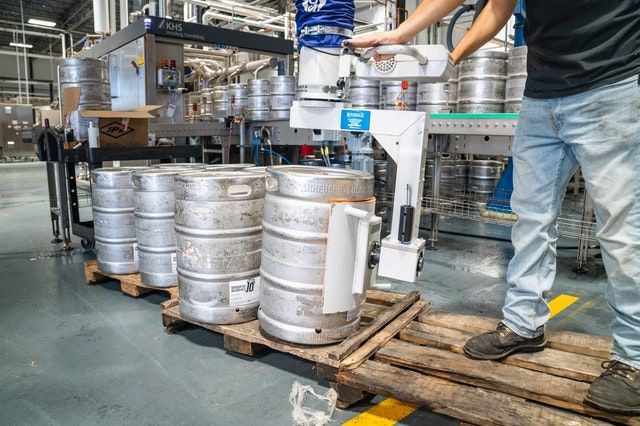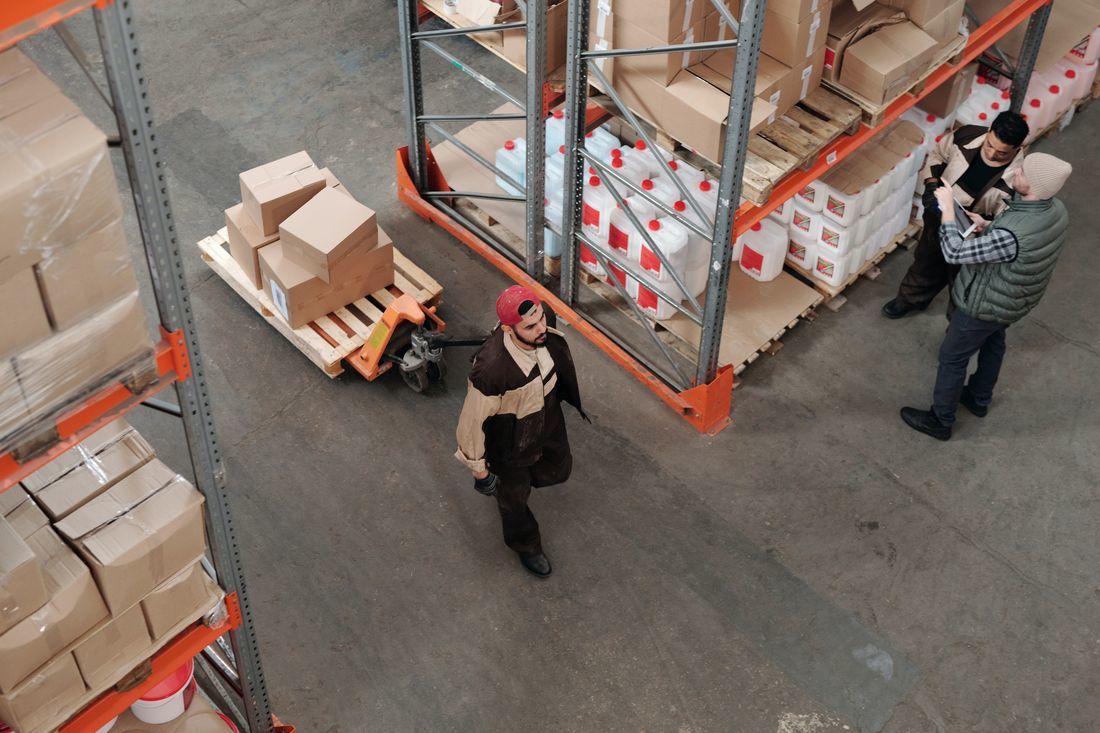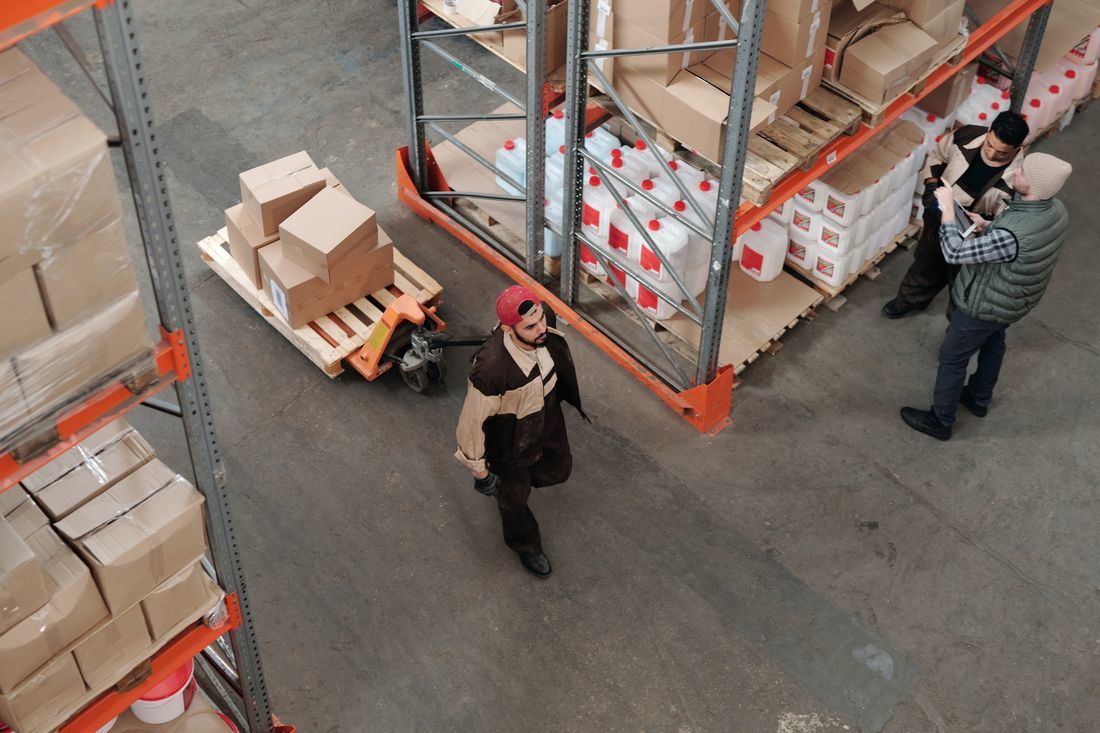This post is to help those involved in warehousing and storage to reduce the number of injuries and cases of occupational ill-health. It contains simple advice that you should be able to apply to your factory, warehousing or storage business.
It is aimed at both employers and employees of those in the storage and warehousing industry, as well as those who work at or around warehouses in the course of their jobs, such as hauliers and couriers.
Causes of Warehouse Accidents
The main causes of accidents in warehousing and storage are:
- slips and trips
- manual handling
- work at height
- vehicles in and around the warehouse
- moving or falling objects.
The dangerous nature of the factory, warehouse and storage industry means that warehouse health and safety needs to be a major priority. As an industry, it has a higher than average rate of non-fatal injuries per 100,000 workers compared to all other industries
Warehousing work activities create numerous health and safety risks. If you fail to control them, your warehouse may face a high employee turnover, underperforming staff, injuries and illnesses, lost working days, legal issues, and, at worst, fatalities.
As an employer, supervisor, or manager, you are legally required to implement and maintain safety procedures. Safety measures must protect workers from warehouse hazards and ensure that they can carry out work activities safely.
You should also focus on promoting thorough warehouse safety procedures for reasons beyond compliance. Maintaining good practices shows that you value staff wellbeing and want to do things right, which boosts motivation and increases trust in your leadership.
HPOM believes Pre-employment medicals are integral to your company's injury prevention plan.
Warehouse Safety Tips
Slips, Trips, and Falls
Statistics show that slips and trips are one of the most common causes of work-related injuries in Australia.
Slips and trips resulting in falls are responsible for nearly half of all reported injuries. Such injuries can be serious. Some can even be fatal. Managers in factory, warehousing or storage facilities should ensure that they are controlling the risks of slips and trips as effectively as possible.
Slips and trips
Slip and trip accidents are a serious problem in warehousing and storage and can happen anywhere. Often they’re brushed off as trivial, but most of these incidents can be avoided.
Slips
Slips usually happen because the floor is wet or contaminated.
Within warehouses, water, oil, cleaning products, dry powders and foodstuffs can all make the floor more slippery. Other items, like stretch wrapping, label backing and plastic bags, can also cause slips.
Slip Prevention
Try to stop the floor getting contaminated, eg by maintaining equipment properly. When contamination does happen, deal with it immediately, eg by cleaning. Most floors have good slip resistance when they are clean, dry and level. However, smooth floors that become even a tiny bit wet or contaminated will be slippery; the rougher the floor, the better it will cope with water and other contamination and the less likely someone is to slip.
The right footwear can help reduce slips but only consider issuing footwear to control slip risks as a last resort – try to eliminate the root of the problem first.
Trips
Objects on the floor or uneven surfaces are usually the cause of trips. Trip hazards
can include items like goods, waste packaging, banded strapping loops and pallets.
Trip Prevention
Plan workflows and storage to make sure that goods, equipment and waste do not
cause obstructions or project into places where people may walk. Keep floors and
traffic routes free from obstructions. Check that floor surfaces are even both inside
and outside buildings and fill in any holes. Provide good lighting.
Good housekeeping is important; if items fall onto traffic routes, clear them as soon as
possible. Also inspect the workplace regularly to make sure that there are no trip hazards.

To prevent slips, trips, and falls in warehouses, you should:
Complete a risk assessment
As a starting point, warehouse managers should ensure that a suitable and sufficient risk assessment is completed which identifies any slip and trip hazards in their warehouse, and determine who might be at risk. The assessment should be supported by the implementation of suitable prevention and control measures which seek to eliminate the hazards completely, wherever possible, or reduce them to a minimum if not.
Risk assessments should cover all areas of the warehouse area. They should include outdoor and indoor areas, and pay particular attention to thoroughfares such as pathways, pavements, steps, stairways, loading docks etc.
Assessments should be recorded and regularly reviewed to ensure that precautions remain adequate to deal with the risks, especially if any significant changes to the premises take place.
Make sure the most common hazards are covered
The most common slip and trip hazards in factory and warehouse environments include:
- slippery or wet floors, eg after a floor has been washed, if water is spilt in the toilets or in kitchens or break rooms, rainwater around entrances, etc
- spillages that are not cleaned up immediately
- worn areas of floor, or raised edges of floor tiles
- clutter and rubbish items left on the floor
- trailing wires, cables and power leads (including temporary plugged-in devices)
- low-level open drawers, or protruding or obstructing furniture
- variable floor levels, slopes and steps, especially if they are not obvious
Wherever practicable install non-slip floors in higher risk areas
Higher risk areas might include toilets and eating areas such as canteens or break room areas where spillages are more likely to occur. In these areas, it may be advisable to fit non-slip floor surfaces wherever possible. These are generally “rougher” than normal floors and allow a better grip.
The selection and fitting of suitable floor surfaces can be complex and will vary from building to building.
Ensure staff know how to carry out good housekeeping. They should clean up spillages, remove obstructions from paths, keep cables tidied away, etc.
Keep floors free of contamination and spillages
People rarely slip on a clean dry floor. Most floors are not inherently slippery and only become so once they become contaminated with substances such as water, oil, grease, detergent, body fluids, dust, etc.
Reducing or eliminating the potential for contamination will greatly reduce the risk of slip accidents occurring.
All spillages can cause a slip, no matter how small. It is essential that they are cleaned up as soon as possible. Body fluid spills also constitute an infection control risk and should be covered by suitable policies and procedures.
- Ensure cleaning staff display appropriate warning signs. Try to schedule cleaning outside of normal work hours so it puts fewer people at risk. Also make sure that cleaners use the correct method and detergent for your type of warehouse floor.
- Use anti-slip paint. It prevents dust from building up, reduces the slip quality of the floor surface, minimises wear and tear, and improves cleaning.
- Use anti-slip tape and shoes. Tape is useful for stairs and other areas where you can’t use anti-slip paint, while non slip soles help people remain safe even if they do encounter a slip hazard.
- Make sure floors are level – uneven flooring can cause people to lose their footing. This is especially dangerous if they’re carrying a load.
- Use heavy-duty cord covers if you must run cables across the floor. As well as preventing trips, covers also protect cables in case a vehicle runs over them.
- Train staff to work at height safely. Ladder safety is particularly important because misuse or use of an unstable ladder can lead to serious injury or even death. Make sure workers use them for no longer than 30 minutes, stay off the top 3 rungs, and maintain three points of contact at all times (e.g. two feet and one hand).

Training
Training workers in health and safety is a legal requirement. They must understand how to work safely with warehouse equipment and how to uphold health and safety control measures.
All warehouses and factory environments should have a policy on slips and trips which is agreed with workforce representatives.
Any work to identify and control hazards should be planned with staff who should be trained and made aware of the dangers. New staff should be introduced to the key points of relevant policies and procedures during induction. Key safety information should also be provided to any temporary staff.
Most importantly, make sure workers know to immediately report hazards to you or another senior staff member.
Report accidents and incidents
Staff should be encouraged to report any slip or trip accidents whether they result in injury or not. This includes “near misses” which would have caused an accident but for chance.
Managers should take all incident reports seriously and investigate the causes, taking appropriate remedial action to prevent any recurrence. Reports should be regularly reviewed to identify trends or training needs.
If any of your workers have been injured in the workplace get in touch with HPOM, we specialise in pre-employment medical examination, occupational health treatment and workplace injury management for warehouse workers.

